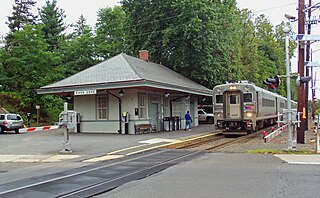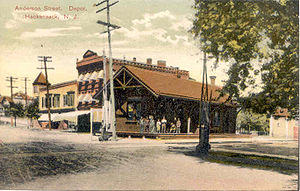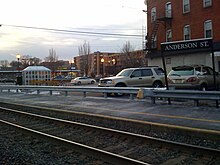
The Pascack Valley Line is a commuter rail line operated by the Hoboken Division of New Jersey Transit, in the U.S. states of New Jersey and New York. The line runs north from Hoboken Terminal, through Hudson and Bergen counties in New Jersey, and into Rockland County, New York, terminating at Spring Valley. Service within New York is operated under contract with Metro-North Railroad. The line is named for the Pascack Valley region that it passes through in northern Bergen County. The line parallels the Pascack Brook for some distance. The line is colored purple on system maps, and its symbol is a pine tree.

NJ Transit Rail Operations is the rail division of NJ Transit. It operates commuter rail service in New Jersey, with most service centered on transportation to and from New York City, Hoboken, and Newark. NJ Transit also operates rail service in Orange and Rockland counties in New York under contract to Metro-North Railroad. The commuter rail lines saw 57,179,000 riders in 2023, making it the third-busiest commuter railroad in North America and the longest commuter rail system in North America by route length.

The Bergen County Line is a commuter rail line and service owned and operated by New Jersey Transit in the U.S. state of New Jersey. The line loops off the Main Line between the Meadowlands and Glen Rock, with trains continuing in either direction along the Main Line. It is colored on NJT system maps in grey, and its symbol is a cattail, which are commonly found in the Meadowlands where the line runs.

The Morristown Line is an NJ Transit commuter rail line connecting Morris and Essex counties to New York City, via either New York Penn Station or Hoboken Terminal. Out of 60 inbound and 58 outbound daily weekday trains, 28 inbound and 26 outbound Midtown Direct trains use the Kearny Connection to Penn Station; the rest go to Hoboken. Passengers can transfer at Newark Broad Street or Summit to reach the other destination. On rail system maps the line is colored dark green, and its symbol is a drum, a reference to Morristown's history during the American Revolution.

New Bridge Landing, signed as New Bridge Landing at River Edge, is an active commuter railroad station in the borough of River Edge, Bergen County, New Jersey. Located at the junction of Kinderkamack Road and Grand Avenue and next to Route 4, the station is serviced by Pascack Valley Line trains running between Hoboken Terminal in Hoboken and Spring Valley station in the eponymous village in Rockland County, New York. The next station to the north is the eponymous River Edge and the next station to the south is Anderson Street in Hackensack. The station contains a single low-level side platform on the southbound side of the track, resulting in the station not being accessible for handicapped persons per the Americans with Disabilities Act of 1990.

Teterboro is a commuter railroad station for NJ Transit in the borough of Hasbrouck Heights, Bergen County, New Jersey, United States. The station is located on the Pascack Valley Line near U.S. Route 46 (US 46) and Teterboro Airport between Wood-Ridge and Essex Street. Teterboro station consists of one low-level platform with a shelter accessible at the Catherine Street and US 46 ramps.

Wood-Ridge is an active commuter railroad train station in the borough of Wood-Ridge, Bergen County, New Jersey. Located next to the interchange of Route 17 and Moonachie, the single low-level side platform station services trains of New Jersey Transit's Pascack Valley Line between Hoboken Terminal and Spring Valley. The next station to the north is Teterboro and to the south is Secaucus Junction. Wood-Ridge station is not accessible to handicapped persons and contains parking along Park Place East.

Oradell is a grade-level commuter rail station for New Jersey Transit in the borough of Oradell, Bergen County, New Jersey. Located at the intersection of Oradell Avenue and Maple Avenue, the station serves trains on the Pascack Valley Line.

Emerson is an active commuter railroad station in the borough of Emerson, Bergen County, New Jersey. The station, serviced by trains of the Pascack Valley Line from Spring Valley in Rockland County, New York to Hoboken Terminal in Hudson County, New Jersey, is located at the intersection of Kinderkamack Road and Linwood Avenue in Emerson. The next station to the north is Westwood while the next to the south is Oradell. The station has a single track and single low-level side platform along Kinderkamack Road, without handicap accessibility under the Americans with Disabilities Act of 1990.

Westwood is an NJ Transit railroad station in Westwood, New Jersey. It is on the Pascack Valley Line and is located at Broadway and Westwood Avenue. The next station northbound, heading toward Spring Valley, New York, is Hillsdale. The next station southbound, headed for Hoboken Terminal, is Emerson. The station consists of one track, one low-level platform with a miniature high-level platform and a station depot maintained by the borough of Westwood. Westwood also maintains the parking lots, consisting of 226 parking spaces, six of which are accessible based on the Americans With Disabilities Act of 1990.

Hillsdale is an active commuter railroad station in the borough of Hillsdale, Bergen County, New Jersey. Servicing trains on New Jersey Transit's Pascack Valley Line, the station is located at the intersection of Broadway and Hillsdale Avenue. The next station to the north toward Spring Valley station is Woodcliff Lake and the next station to the south toward Hoboken Terminal is Westwood. The station contains one track while a single low-level side platform next to the station depot, resulting in no accessibility for handicapped persons under the Americans with Disabilities Act of 1990.

Woodcliff Lake is an active commuter railroad station in the borough of Woodcliff Lake, Bergen County, New Jersey. Located at the junction of Woodcliff Avenue and Broadway on the edge of the Woodcliff Lake Reservoir, the station is served by trains of New Jersey Transit's Pascack Valley Line. The station, which contains a single track and low-level side platform, is not accessible per handicapped persons under the Americans with Disabilities Act of 1990. As of November 8, 2020, Woodcliff Lake is serviced seven days a week by New Jersey Transit trains, having previously only been a single train on weekends and holidays up to that point.

Park Ridge is an active commuter railroad station in the borough of Park Ridge, Bergen County, New Jersey. Located at the intersection of Park and Hawthorne Avenues, the station services trains on the Pascack Valley Line, which runs from Hoboken Terminal to Spring Valley station in New York. The station contains a single low-level side platform split by Park Avenue and a wooden station depot, built by the Hackensack and New York Extension Railroad. As a result, Park Ridge station is not handicap accessible under the Americans with Disabilities Act of 1990.

Montvale is an active commuter railroad station in the borough of Montvale, Bergen County, New Jersey. Located in the middle of an active road junction of East Grand Avenue and Kinderkamack Road, the station serves trains on New Jersey Transit's Pascack Valley Line, serving as the first/last stop in New Jersey. The station consists of one low-level side platform with a mini-high-level platform to service handicapped customers under the Americans with Disabilities Act of 1990.

The New Jersey and New York Railroad (NJ&NY) was a railroad company that operated north from Rutherford, New Jersey, to Haverstraw, New York beginning in the mid-to-late 19th century.

The Hackensack and New York Railroad was a New Jersey railroad company which was chartered in 1856. The railway ran from Rutherford, New Jersey to Hackensack, New Jersey and service started in 1858. Construction along a northward extension of the line known as the Hackensack and New York Extension Railroad under the leadership of David P. Patterson started in 1866. Service to Hillsdale opened on March 4, 1870.

Fairmount Avenue is a former New Jersey Transit rail station on the Pascack Valley Line. The station was one of three rail stations in Hackensack, New Jersey, and was located at Fairmount Avenue and Temple Avenue. The Essex Street and Anderson Street stations are also located in Hackensack. The station house was built in 1870 as part of the extension railroad for the Hackensack and New York Railroad on a track extension from Anderson Street in Hackensack. The line became part of the Erie Railroad in 1896 and New Jersey Transit in 1983.

Essex Street, known as Hackensack during the Erie Railroad era, is a New Jersey Transit rail station on the Pascack Valley Line, located in Hackensack, New Jersey, at 160 John Street. The Pascack Valley Line services this station seven days a week.

The Montclair-Boonton Line is a commuter rail line of New Jersey Transit Rail Operations in the United States. It is part of the Hoboken Division. The line is a consolidation of three individual lines: the former Delaware, Lackawanna & Western Railroad's Montclair Branch, which ran from Hoboken Terminal to Bay Street, Montclair. The Erie Railroad's Greenwood Lake Division, a segment from Montclair to Mountain View-Wayne, originally ran from the Jersey City Terminal to Greenwood Lake, NY, and the former Lackawanna Boonton Line ran from Hoboken to Hackettstown, New Jersey.

Hackensack was a railroad station in Hackensack, New Jersey on the New York, Susquehanna and Western Railway Main Line, which provided passenger service between the 1870s and 1960s. The station at Main and Mercer Streets opened in 1872; it was replaced with one at River Street in 1950. Public Service trolley lines served both stations.
























